 Image search results - "ena" Image search results - "ena" |
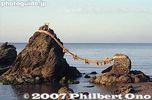
Meoto-Iwa Wedded Rocks off the coast of Futami-cho, Ise city, Mie Prefecture. 夫婦岩
|
|

The Wedded Rocks are part of Futami Okitama Shrine known for frog sculptures. 二見興玉神社
|
|
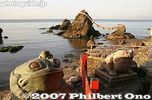
The shrine is dedicated to Sarutahiko and Ukano-mitama. Sarutahiko is a god which serves as a pathfinder guide. Deities for land/sea transportation safety. 二見�
|
|

The frog is Sarutahiko's messenger. Frog is called "kaeru" in Japanese, which is a homonym for the another word meaning "return home." If you travel a lot, pray here for a safe return. 夫婦岩
|
|
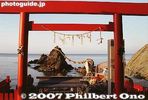
Futami Okitama Shrine does not have a main hall (Honden) like most other shrines. It worships the Okitama Sacred Stone in the ocean beyond the Wedded Rocks. 二見興玉神社
|
|

Lantern and sunset at Futami Okitama Shrine
|
|

Sunset at Futami Okitama Shrine. In the old days when traveling was a hazardous undertaking in Japan, pilgrims who traveled to worship at the Ise Grand Shrines prayed here for a safe return home.
|
|
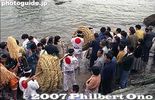
Men carry spanking-new shimenawa ropes to the rocks.
|
|
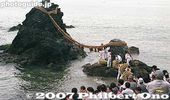
The Wedded Rocks are actually a type of torii gate for worshipping the Okitama Sacred Stone in the ocean.
|
|

The torii on the larger rock is quite small. The sacred rope is replaced three times a year on May 5, September 5, and at the end of December.
|
|
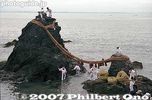
5月5日、9月5日と12月下旬には夫婦岩の大注連縄の張り替え神事が行われる。これらの写真は5月5日に撮影された。
|
|
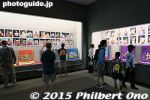
Sumo museum
|
|
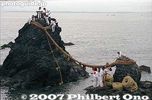
The men begin to cut off the old rope. Those sharp sickles soon made short work of the old sacred ropes which were brought ashore in small pieces.
|
|
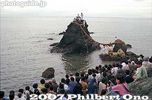
The ceremony attracts a large crowd.
|
|

The shimenawa rope actually consists of five smaller ropes. They cut the ropes one by one.
|
|

The ropes are now completely cut, breaking the bond between the two rocks.
|
|
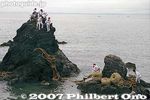
The old rope is taken away.
|
|
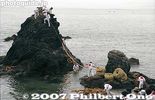
The new ropes are strung across the two rocks. A small rope tied to the end of the large rope is used to pull the large rope up the rock.
|
|
|

The first rope is wound around both rocks.
|
|

The second rope is installed.
|
|
|

One by one, the men carefully positioned the new sacred ropes on the two Rocks. All the while, young children and young men are chanting on the shore.
|
|
|
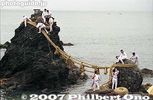
Replacing the rope for the Wedded Rocks, Mie Pref.
|
|

Five ropes are being positioned and made taut.
|
|
|

All the while, the cheering section chants and wave streamers.
|
|
|
|
|
|

Pieces of the old rope. Anyone could take home the pieces of old sacred rope if they wanted.
|
|

Making sure that the rope is aligned and positioned correctly.
|
|
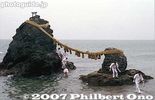
The job is finished.
|
|

The rope installers return to shore.
|
|
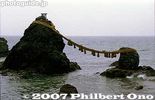
Wedded Rocks with a new rope. Japan has numerous other Wedded Rocks and stones, but this is by far the most famous.
|
|
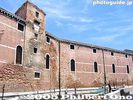
Arsenale アーセナレ会場The Arsenale is a huge, long building housing various art works by 49 artists.
アーセナレ会場は、細長い、とてもでっかい建物の中に個人のアーティストの作品が展示。
|
|
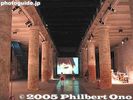
Inside the Arsenale アーセナレの中
|
|

Hippo in the Arsenale
|
|
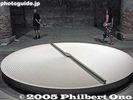
By Mona HatoumThe center bar rotates around as it makes ridges and flattens them.
|
|
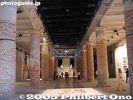
Inside the Arsenale
|
|

Photo exhibition in Arsenale
|
|

Pay phones housed by birds, by Sergio VegaOutside the Arsenale there were these pay phones.
|
|
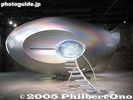
Mariko Mori at the Arsenale 森 万里子のUFOHer trademark UFO.
|
|
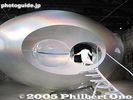
Mariko Mori 中にも入れるThree people at a time could go inside and watch some kind of video.
三人が入れる。
|
|
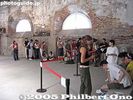
Line to enter Mariko Mori's UFO UFOに入るために並んでいる
|
|
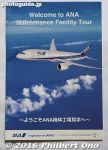
ANA (All Nippon Airways) offers free tours of their maintenance facilities at Haneda Airport in Tokyo. You can see planes in a huge hangar being serviced.You have to make reservations at their website, but everything is in Japanese. They have four 90-min. tours almost daily, but only in Japanese. (Pamphlet has some English.) You should reserve weeks or months in advance because tours get booked up quickly. However, when people cancel their reservations, tours may open up. You have to keep checking. Children must be at least elementary school age. http://www.ana.co.jp/group/kengaku/outline.html
|
|

From Haneda Airport's International terminal, you can see ANA's maintenance hangars at the end of Runway A which is one of the airport's original runways.
|
|

After passing the JAL maintenance hangar, you will see this overpass connecting the ANA buildings.
|
|

On the left is the ANA Component Maintenance Building where you check-in for the tour. Show the security guard your reservations (printout of the email confirmation) to enter the building.
|
|

When you enter the building, you will be in the reception lobby.
|
|

Reception lobby of the ANA Maintenance Facility's ANA Component Maintenance Building. There's a gift shop, model planes, and other exhibits. At lunch time, they sold bento so we had lunch here after the tour.
|
|

Gift shop sells ANA goods.
|
|

Pose
|
|

ANA Gundam in the lobby.
|
|

ANA cockpit in the lobby.
|
|
|
|
|

ANA model planes in the lobby.
|
|
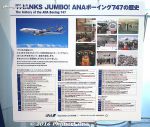
Panel about the 747. ANA retired its last Boeing 747 in March 2014. ANA first flew 747s in 1979. Will be missed.
|
|

In this lecture hall, ANA's tour started with a 30-min. talk and video about flight, their planes, Haneda Airport, etc.Part of ANA's talk was about how planes fly. They demonstrated how wind can lift the wings of a toy plane.
|
|

ANA's lecture hall has some exhibits like model planes.
|
|

ANA's whale plane.
|
|

ANA's Peanuts (Charlie Brown) plane.
|
|

Tire, cockpit window, lights.
|
|

Free souvenir of the tour. Cell phone strap with an ANA maintenance man.
|
|
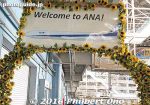
After the slide show lecture, we wore a hard hat and walked on the overpass to the plane hangars. There were around 80 people in the tour and they divided us into around 15 people per group for the hangar tour. Each group had a guide explaining things in Japanese.
|
|

ANA's airplane maintenance hangar at Haneda Airport. Photography was permitted, but no videos. You can post photos online, but you need their approval. These photos here have been approved by ANA. They don't allow ANA personnel and the other tour participants to be pictured. Also cannot show any non-ANA plane.
|
|
|
|

ANA's Boeing 787
|
|

ANA's Boeing 787 inside the maintenance hangar at Haneda Airport.
|
|

Engine removed from the plane.
|
|

Passenger seats were taken out and the cushions replaced.
|
|
|

Where the tail fits.
|
|

Tires
|
|

Tires
|
|

Tires are not that huge. Tires are inflated with nitrogen, not air (one thing that they always mention).
|
|

They have to replace the tires quite often, every 2 months or so.
|
|
|

Extra hangar space.
|
|
|

Jet engine undergoing maintenance.
|
|

Jet engine undergoing maintenance.
|
|
|
|
|
|

The hangar can get very noisy when they are testing an engine.
|
|

ANA plane
|
|

Always impressive to see a jet plane up close. We see it only on the outside, cannot go inside the plane.
|
|
|
|
|
|
|
|

ANA plane parked outside the maintenance hangar.
|
|

Extra dock in the maintenance hangar.
|
|
|

Jet engine cowlings.
|
|

How workers get around. Enjoyed the tour.
|
|

Sacred rock where the god lives.
|
|

Enakyo is a scenic, gorge-like area along the Kiso River. Noted for cherry blossoms in spring, autumn colors in November, and unusual rock formations.
|
|

Enakyo or Ena Gorge is in the city of Ena (pop. 47,000 as of Nov. 2021) next to Nakatsugawa in eastern Gifu Prefecture.
|
|
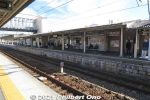
Nearest train station is JR Ena Station on the JR Chuo Line. It's about 70 min. from Nagoya Station in Aichi Prefecture.
|
|
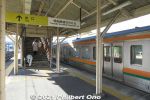
JR Ena Station platform and JR Chuo Line.
|
|
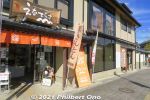
JR Ena Station has a tourist information center right inside and outside.
|
|
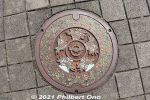
Manhole in Ena, Gifu.
|
|
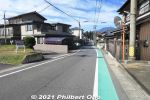
There are buses running from JR Ena Station to Enakyo Gorge, but they run very infrequently. Since the next bus was a one-hour wait (and 15-min. ride), I decided to walk it and not miss the sunny day. I was told it would take 1 hour. Or ¥2,000 by taxi.
|
|
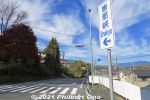
Walking to Enakyo. The tourist information lady gave me a map to walk to Enakyo. Easy to follow.
|
|
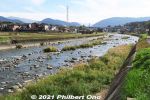
Agi River.
|
|
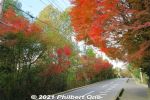
There were a few maple (momiji) trees along the way.
|
|
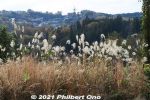
Pampas grass too.
|
|
|
|
|
|
|
|
|
|
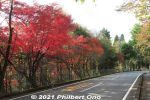
Although I was rewarded with these red maples, one-hour is kind of a long walk. Slight uphill too.
|
|
|
|
|
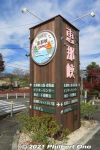
Finally, the Enakyo sign.
|
|
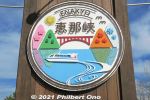
Enakyo marker sign.
|
|
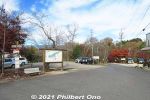
Enakyo bus stop.
|
|
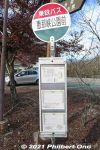
If you take a bus, get off here at Enakyo Koen-mae. Also check the return bus schedule. Buses run very infrequently.
|
|
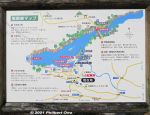
On this map of Enakyo Gorge, No. 3 and 4 are Sazanami Park, No. 5 is the boat cruise pier, and No. 2 is Oi Dam which created this river reservoir.
|
|
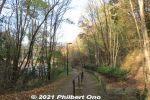
From the bus stop, there's a short path down to the riverside.
|
|
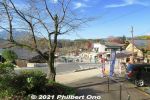
Cross the road and there's the starting point to explore Enakyo. Building on the left is the Visitors' Center.
|
|

Map of Enakyo. There's a sightseeing boat pier on the left, a few hotels, and a small spit of land that is Sazanami Park, one main attraction.
|
|
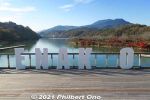
Most tourists visiting Enakyo will first arrive here, a short walk from the bus stop and parking lot. The "Y" is missing here. Maybe it was designed to have a human posing as the "Y" in a selfie.
|
|
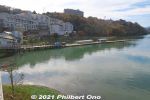
On the left is a pier for sightseeing boats taking tourists to see the unusual rock formations on the gorge. Cruise is 30 min. and fare is ¥1,500. Runs often during autumn. https://www.tohsyoh.jp/ship
|
|
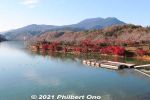
On the right is Sazanami Park lined with autumn maple leaves in November and cherry blossoms in spring. Everything is within a short walk. These photos were taken in November.
|
|
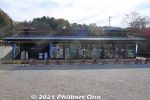
Enakyo Visitors Center has tourist information counter and air-conditioned rest area with tables and chairs.
|
|
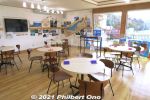
Inside Enakyo Visitors Center.
|
|

Sights in Enakyo Gorge.
|
|

Sights and wildlife in Enakyo Gorge.
|
|
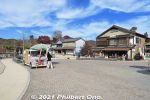
Gift shops at Enakyo.
|
|
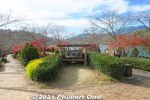
Entering Sazanami Park lined with red maple trees in autumn. "Sazanami" means "water ripples."
|
|
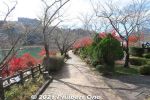
Sazanami Park has a small peninsula with a walking path lined with maple trees (and cherry trees).
|
|
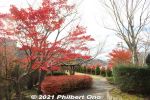
Entering Sazanami Park lined with red maple leaves in mid-November.
|
|
|
|
|
|
|
|
|
|
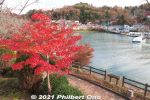
Left side of Sazanami Park facing the boat pier.
|
|
|
|
|
|
|
|
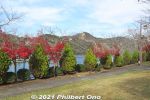
The park has two levels. Lower level is a path along the riverside, and this upper level is a park-like lawn.
|
|
|
|
|
|
|
|
|
|
|
|
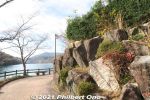
Approaching the tip of Sazanami Park.
|
|
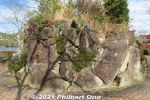
Rocks on the tip of Sazanami Park.
|
|
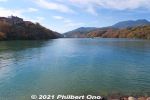
View of Kiso River from the tip of Sazanami Park. Right below Shinonome Ohashi Bridge (東雲大橋) in the distance is Oi Dam built in 1924 as Japan's first hydroelectric dam. The dam created this reservoir in Ena Gorge.
|
|
|
|
|
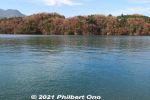
View of the river from the right side of Sazanami Park.
|
|

Upstream toward Enakyo Ohashi Bridge.
|
|
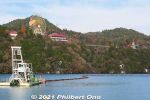
On the right side of Sazanami Park, Ena-kyo Wonderland can be seen on the mountain. An amusement park, closed for winter from Nov. to Feb..
|
|
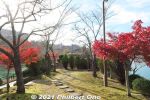
On the upper level of Sazanami Park, looking toward the tip.
|
|
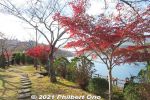
On the upper level of Sazanami Park, looking toward the tip.
|
|
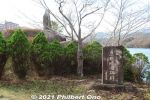
Tanka poetry monument on the tip of Sazanami Park. Lower monument commemorates the development of Enakyo.
|
|
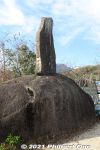
Tanka poem monument for poet Kitahara Hakushu.
|
|
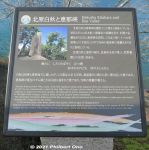
About the tanka poem by poet Kitahara Hakushu.
|
|
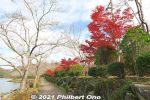
Red maple leaves on the right side of Sazanami Park.
|
|
|
|
|
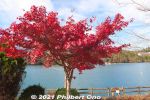
Most maple trees aren't that large, but the river in the background makes them scenic.
|
|
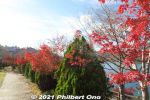
Definitely the right place for red maple leaves. Most were already very red.
|
|
|
|
|
|
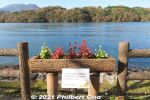
Flowers grown and groomed by Ena Agricultural High School students studying landscape design.
|
|
|
|
|
|
|
|
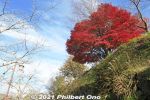
Big maple tree.
|
|
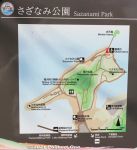
Map of Sazanami Park. You can walk around it in 15-20 min. (Longer if you like to take pictures.)
|
|
|
|
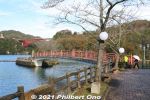
From Sazanami Park, a bridge to Benten Island.
|
|

Bridge to Benten Island.
|
|

Benten Island has a statue of the goddess Benzaiten.
|
|
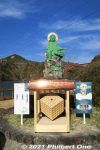
Statue of the goddess Benzaiten and shiny offertory box.
|
|
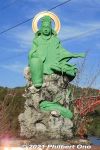
Statue of the goddess Benzaiten, protector against floods and water accidents. Goddess of anything that flows, including music.
|
|

Benten Island is the tip of a mountain now submerged by the dammed river.
|
|
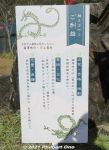
Pray to Benzaiten for success in life, passing exams, love, and art and design.
|
|
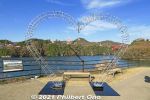
Upper level of Sazanami Park.
|
|

View of Benten Island.
|
|
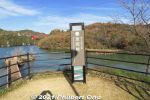
Lookout point on Sazanami Park.
|
|
|
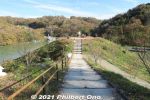
Small hill called Hanamomo-no-Oka.
|
|
|
|
|

Momosuke Square at the top of Sazanami Park. Statue of Fukuzawa Momosuke, son-in-law of Fukuzawa Yukichi. Momosuke built the Oi Dam that created this Enakyo reservoir and hydroelectric power.
|
|
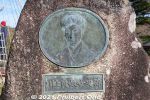
Relief of Kawakami Sadayakko (or Sada Yacco 1871–1946) who was Momosuke's mistress and former geisha who was also previously mistress to Prime Minister Ito Hirobumi. She helped Momosuke build and design seven dams along Kiso River. 川上 貞奴
|
|
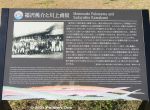
About Fukuzawa Momosuke and Kawakami Sadayakko. Momosuke was inspired by father-in-law Yukichi who said electricity was necessary for Japan's economic development and mechanization.
|
|
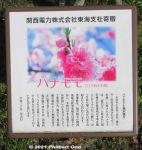
From Germany where he bought water wheels for his hydroelectric power plant, Momosuke brought Hana peach flowers (hanamomo) to Japan.
|
|
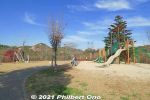
Also a playground for kids.
|
|
|
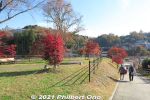
Going back down from Sazanami Park.
|
|
|

Gift shops on the way back to the bus stop.
|
|
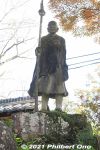
Statue of Buddhist priest Kobo Daishi near the bus stop. Built around 1932 in memory of those who died while building Oi Dam. It was also built to attract tourists. Kobo Daishi founded Shingon Buddhism.
|
|
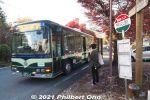
Bus to Ena Station (about 15 min.). They run very infrequently, so be sure to check the return bus schedule.
|
|
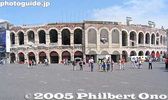
Verona ArenaIt looks smaller than the Rome Coliseum, but what a surprise it was when we went inside.
|
|

Inside the Verona ArenaIt was huge. Here, they are preparing the set for one of the nighttime operas (Aida) held in July.
|
|

JAL (Japan Airiines) offers free tours of their maintenance facilities and their Sky Museum at Haneda Airport in Tokyo. You can see planes in a huge hangar being serviced. You have to make reservations at their website, but everything is in Japanese. They have four 90-min. tours almost daily, but only in Japanese. You should reserve weeks or months in advance because tours get booked up quickly. However, when people cancel their reservations, tours may open up. You have to keep checking. Children must be at least elementary school age. Shin Seibijo Station on the Haneda Monorail. JAL's maintenance hangar is a 10-15 min. walk from Shin Seibijo Station on the Haneda Monorail running from JR Hamamatsucho. http://www.jal.co.jp/kengaku/tour/
|
|

Go to the JAL Maintenance Center 1 Building and show your reservation to the reception. They will give you a pass. You can arrive 30 min. before the tour starts. Use the time to see this Sky Museum.The tour pass is on a JAL cell phone neck strap that you can keep.
*Note that if you take the tour and take pictures and want to post pictures online, you will need JAL's approval. They don't allow photos of JAL personnel and tour guests in online photos. All these photos have been approved by JAL for posting here.
|
|

JAL's "Sky Museum" shows JAL's history, interactive exhibits like a cockpit, first-class seats, and a special room showing special plane seats used by the emperor before Japan got its own Japanese Air Force One. In Japanese only though
|
|
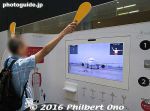
A visitor tries an interactive exhibit for directing a JAL plane to a gate.
|
|

Cabin attendant uniforms throughout JAL's history (including TDA aka Japan Air System that merged with JAL).
|
|

JAL's first cabin attendant uniform appeared in Aug. 1951.
|
|

TDA's (Toa Domestic Airways) cabin attendant uniform (left) and JAS (Japan Air System) cabin attendant uniform. Bot TDA and JAS merged with JAL.
|
|

JAL's cabin attendant uniform worn in the 1970s (left) and 1980s (right).
|
|

History of JAL planes.
|
|

Historical model planes in JAL's Sky Museum. The museum is quite big, and we didn't have time to see everything.
|
|

Model of JAL Boeing 747.
|
|
|

The same type of happi coat the Beatles wore when they got off the JAL DC-8 ("Matsushima") at Haneda for their Budokan concerts in 1966.The back has the kanji for kotobuki (寿) meaning "celebration." Famous story behind how a JAL stewardess got John to wear the happi coat. "Wearing a happi coat when you land in Japan would make the fans really happy!" "Good idea!," said John who then wore it. The other Beatles followed and wore one too. A major, historic PR coup for JAL.
|
|

Vintage JAL luggage tags.
|
|
|
|

JAL's tour also started with a 30-min. talk and slide show in Japanese.
|
|

Wore hard hats and toured JAL's maintenance hangar for about 40 min. JAL's airplane maintenance hangar at Haneda Airport. Huge facility.
|
|

JAL Boeing 787.
|
|

Photography was permitted, but no videos. You can post photos online, but cannot show personnel (I assume faces) and the other tour participants. Also cannot show any plane from another airline which might be taxiing or flying outside in the background.
|
|

The lucky treat of the JAL tour was seeing Japan's Air Force One (actually, Air Force Two). The Japanese government plane that carries the prime minister or emperor.They are normally parked at Chitose Airport in Hokkaido. Flown by the Air Defense Force, but maintained by JAL. Japan's Air Force One/Two will be retired in 2019, to be replaced by Boeing 777. The new Boeing 777 will be maintained by ANA. Photos were allowed, but not allowed to be posted online.
|
|

One corner of the hangar preserved the cockpit/lounge section of the JAL "Fuji" DC-8. This was Japan's first passenger jet put into service in 1960, replacing prop planes. This plane had 104 seats, 36 first class and 68 tourist class.
|
|
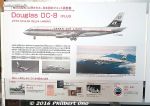
About the JAL "Fuji" DC-8.
|
|

First class section of JAL's "Fuji" DC-8.
|
|
|

Tail of the JAL "Fuji" DC-8. Looks like they are restoring the plane.
|
|

JAL plane parked outside the maintenance hangar.JAL sent out an online questionaire afterward for feedback about the tour. I told them that many foreigners were also interested in the tours so they should provide foreign language info too. I'm told that there are no tours like this in the States.
|
|
|
|
|
|
|

Site of Ogaki Castle's Takebashi-guchi Gate
|
|
|
|
|